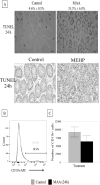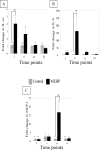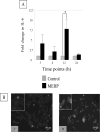Mono-(2-ethylhexyl) phthalate-induced Sertoli cell injury stimulates the production of pro-inflammatory cytokines in Fischer 344 rats
- PMID: 28238932
- PMCID: PMC5406244
- DOI: 10.1016/j.reprotox.2017.02.013
Mono-(2-ethylhexyl) phthalate-induced Sertoli cell injury stimulates the production of pro-inflammatory cytokines in Fischer 344 rats
Abstract
Exposure of rodents to the Sertoli cell (SC) toxicant mono-(2-ethylhexyl) phthalate (MEHP) has been reported to trigger an infiltration of macrophages into the testis in an age- and species-dependent manner. Here we challenge the hypothesis that the peripubertal rat-specific infiltration of macrophages after MEHP exposure is due, in part, to an increase in SC-specific inflammatory cytokine expression. To rule out that germ cell(GC) apoptosis itself is responsible for macrophage recruitment, rats were exposed to a direct GC toxicant, methoxyacetic acid (MAA), but no infiltration of macrophages was observed. Next, mRNA levels of inflammatory cytokines were evaluated after MEHP exposure. IL-1α, IL-6, and MCP-1 expression were increased in vivo and correlated with macrophage infiltration in a species-specific manner. Additionally, IL-6 and MCP-1 expression was increased in SC-GC co-cultures and ASC-17D SCs. These results indicate that MEHP-injury in pubertal rats specifically stimulates secretion of pro-inflammatory cytokines and alters the immune microenvironment.
Keywords: Cytokines; Mono-(2-ethylhexyl) phthalate; Sertoli cells; Testicular macrophages.
Copyright © 2017 The Author(s). Published by Elsevier Inc. All rights reserved.
Figures






Similar articles
-
Age- and species-dependent infiltration of macrophages into the testis of rats and mice exposed to mono-(2-Ethylhexyl) phthalate (MEHP).Biol Reprod. 2014 Jul;91(1):18. doi: 10.1095/biolreprod.113.115527. Epub 2014 May 29. Biol Reprod. 2014. PMID: 24876407 Free PMC article.
-
Mono-(2-ethylhexyl) phthalate rapidly alters both Sertoli cell vimentin filaments and germ cell apoptosis in young rat testes.Toxicol Appl Pharmacol. 1996 Mar;137(1):42-50. doi: 10.1006/taap.1996.0055. Toxicol Appl Pharmacol. 1996. PMID: 8607140
-
MEHP-induced rat testicular inflammation does not exacerbate germ cell apoptosis.Reproduction. 2018 Jul;156(1):35-46. doi: 10.1530/REP-18-0093. Epub 2018 May 9. Reproduction. 2018. PMID: 29743262 Free PMC article.
-
TNF alpha-mediated disruption of spermatogenesis in response to Sertoli cell injury in rodents is partially regulated by MMP2.Biol Reprod. 2009 Mar;80(3):581-9. doi: 10.1095/biolreprod.108.073122. Epub 2008 Nov 26. Biol Reprod. 2009. PMID: 19038859 Free PMC article.
-
Concerns about the widespread use of rodent models for human risk assessments of endocrine disruptors.Reproduction. 2014 Mar 6;147(4):R119-29. doi: 10.1530/REP-13-0497. Print 2014. Reproduction. 2014. PMID: 24497529 Free PMC article. Review.
Cited by
-
Peritubular Macrophages Are Recruited to the Testis of Peripubertal Rats After Mono-(2-Ethylhexyl) Phthalate Exposure and Is Associated With Increases in the Numbers of Spermatogonia.Toxicol Sci. 2021 Aug 3;182(2):288-296. doi: 10.1093/toxsci/kfab059. Toxicol Sci. 2021. PMID: 34010400 Free PMC article.
-
Exposure to the non-phthalate plasticizer di-heptyl succinate is less disruptive to C57bl/6N mouse recovery from a myocardial infarction than DEHP, TOTM or related di-octyl succinate.PLoS One. 2023 Jul 13;18(7):e0288491. doi: 10.1371/journal.pone.0288491. eCollection 2023. PLoS One. 2023. PMID: 37440506 Free PMC article.
-
High-content imaging analyses of the effects of bisphenols and organophosphate esters on TM4 mouse Sertoli cells†.Biol Reprod. 2022 Sep 12;107(3):858-868. doi: 10.1093/biolre/ioac101. Biol Reprod. 2022. PMID: 35596243 Free PMC article.
-
The blood-testis barrier disruption is a prerequisite for toxicant-induced peritubular macrophage increases in the testis of peripubertal rats.Toxicol Sci. 2024 Jun 26;200(1):70-78. doi: 10.1093/toxsci/kfae043. Toxicol Sci. 2024. PMID: 38565259 Free PMC article.
-
Crude saponin from Korean red ginseng alleviates di(2-ethylhexyl) phthalate-induced urogenital damage via regulating p38 MAPK/NF-κB signaling.J Ginseng Res. 2025 Sep;49(5):532-540. doi: 10.1016/j.jgr.2025.04.009. Epub 2025 May 2. J Ginseng Res. 2025. PMID: 40843017 Free PMC article.
References
-
- O’Bryan MK, Hedger MP. Inflammatory networks in the control of spermatogenesis : chronic inflammation in an immunologically privileged tissue? Adv Exp Med Biol. 2008;636:92–114. - PubMed
-
- Hedger MP, Winnall WR. Regulation of activin and inhibin in the adult testis and the evidence for functional roles in spermatogenesis and immunoregulation. Mol Cell Endocrinol. 2012 Aug 15;359(1–2):30–42. - PubMed
-
- Campese AF, Grazioli P, de Cesaris P, Riccioli A, Bellavia D, Pelullo M, et al. Mouse Sertoli cells sustain de novo generation of regulatory T cells by triggering the notch pathway through soluble JAGGED1. Biol Reprod. 2014 Mar;90(3):53. - PubMed
Publication types
MeSH terms
Substances
Grants and funding
LinkOut - more resources
Full Text Sources
Other Literature Sources
Miscellaneous

